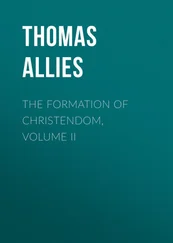Thomas Allies - Peter's Rock in Mohammed's Flood, from St. Gregory the Great to St. Leo III
Здесь есть возможность читать онлайн «Thomas Allies - Peter's Rock in Mohammed's Flood, from St. Gregory the Great to St. Leo III» — ознакомительный отрывок электронной книги совершенно бесплатно, а после прочтения отрывка купить полную версию. В некоторых случаях можно слушать аудио, скачать через торрент в формате fb2 и присутствует краткое содержание. Издательство: Иностранный паблик, Жанр: foreign_antique, foreign_prose, Историческая проза, на английском языке. Описание произведения, (предисловие) а так же отзывы посетителей доступны на портале библиотеки ЛибКат.
- Название:Peter's Rock in Mohammed's Flood, from St. Gregory the Great to St. Leo III
- Автор:
- Издательство:Иностранный паблик
- Жанр:
- Год:неизвестен
- ISBN:нет данных
- Рейтинг книги:4 / 5. Голосов: 1
-
Избранное:Добавить в избранное
- Отзывы:
-
Ваша оценка:
- 80
- 1
- 2
- 3
- 4
- 5
Peter's Rock in Mohammed's Flood, from St. Gregory the Great to St. Leo III: краткое содержание, описание и аннотация
Предлагаем к чтению аннотацию, описание, краткое содержание или предисловие (зависит от того, что написал сам автор книги «Peter's Rock in Mohammed's Flood, from St. Gregory the Great to St. Leo III»). Если вы не нашли необходимую информацию о книге — напишите в комментариях, мы постараемся отыскать её.
Peter's Rock in Mohammed's Flood, from St. Gregory the Great to St. Leo III — читать онлайн ознакомительный отрывок
Ниже представлен текст книги, разбитый по страницам. Система сохранения места последней прочитанной страницы, позволяет с удобством читать онлайн бесплатно книгу «Peter's Rock in Mohammed's Flood, from St. Gregory the Great to St. Leo III», без необходимости каждый раз заново искать на чём Вы остановились. Поставьте закладку, и сможете в любой момент перейти на страницу, на которой закончили чтение.
Интервал:
Закладка:
Sophronius addressing his colleagues began with regretting that he was advanced to the pontifical throne from a very humble state against his will. Begging his fathers and brethren to support him, he noted that it was an apostolic custom throughout the world that they who were thus advanced, should attest their faith to the colleagues preceding them. After this introduction, Sophronius threw his words into the form of a creed, in which the first part dwelt upon the Trinity. He then, at greater length, set forth his belief in the Incarnation. How God the Son, taking pity upon the fall of man, by His own will, and the will of His Father, and the divine good pleasure of the Spirit, being of the infinite nature, incapable of circumscription and of local passage, entered the virginal womb, resplendent in its purity, of Mary the holy, the God-minded, the free from every contamination of body, of soul, and of mind; the fleshless took flesh, the formless, in His divine substance, took our form; the eternal God becomes in truth man. He, who is in the bosom of the eternal Father is bosomed in a mother's womb. He who is without time receives a beginning in time. Then, passing to the point in question, he went on: Christ is One and Two, One in Person, Two in Natures and their natural attributes. On this account, One and the same Christ and Son, and Only-begotten is found undivided in both natures. He worked physically the works of each nature according to the essential quality or natural property which belonged to each. This He could not have done, had He possessed, as One only Person, so One only Nature, not compounded. For then, the One and the Same would not have completely done the works of each Nature. For when has Godhead without body worked naturally the works of the body? or, when has a body without Godhead worked works which substantially belong to the Godhead? But Emmanuel, being One, and in this Oneness both, that is, God and Man, did, in truth, the works of each Nature; being One and the Same, as God He did the divine, as Man the human works. Being One and the Same, He works and He speaks the divine and the human. Not one wrought miracles, and another did human works, and suffered pains, as Nestorius meant, but one and the same Christ and Son wrought the divine and the human according to each, as St. Cyril taught. In each of the Two Natures He had the two powers unmingled, but undivided. As He is eternal God, He wrought the miracles; as He was Man in the last times, He wrought the inferior and human works.
The answer to the Synodical letter of Sophronius, made by Sergius at Constantinople, was not to receive it, but to draw up his own Ecthesis, and prevail on the emperor Heraclius to stamp it with the imperial signature, and proclaim it as the faith of his empire. Before the Ecthesis was brought to Rome in December, 638, Pope Honorius had died in the preceding October. Sophronius had commissioned the chief bishop of his patriarchate, Stephen of Dor, as we have already seen, to carry his appeal to Honorius, in the See of Peter. And now it is time to turn to those events which were in the meanwhile happening in the eastern empire.
In the three hundred years from Constantine to his twenty-second successor, Heraclius, the empire which he had set up in the fairest city of the world had developed into a double despotism. It is difficult to say whether that despotism pressed more severely on the religious or on the civil well-being of its subjects. As to each, it is requisite to say something. The gravity of the events which took place within ten years demands it; while in their permanent effect that gravity most of all consists. The immediate result was most rapid and unexpected, yet a long train of action during the three hundred years preceding had led straight up to it, and a period of four times three hundred years has since witnessed its evolution.
Let us take first this pressure of despotism on religion. In speaking of Constantine I noted that there were in him two very distinct periods of his rule after he became a Christian. The first precedes his acquisition of the whole empire in 323; the second follows in the fourteen years from that time to his death. But in this second period the change, which dates from the moment at which he becomes sole emperor, is yet gradual. At the first General Council, in 325, the calling of which is agreed to by the Pope and the eastern patriarchs, but springs from himself, he acknowledges both in word and conduct that the Christian Church is the kingdom of Christ, and that its government lies in the hands of those who receive a divine consecration thereto from Christ. They are the witnesses of His doctrine, which they maintain and promulgate in virtue of that consecration. Upon this doctrine their judgment is final. Constantine never in thought submitted to any power but the Catholic Church. The thought of warring sects was abhorrent equally to the soldier, the conqueror, and the legislator. Yet before his reign closed, at the age of sixty-three, he had been seduced in his conduct from this high tone of action by the counsels of the Court bishop, Eusebius; he had restored Arius and persecuted Athanasius. He had selected the bishops who were to attend local councils, while he stretched the powers of such local councils beyond their competence. He had in fact advanced with his imperial sword into the Church's Council Chamber, and claimed to be a judge of her doctrine. And his kingdom was forthwith divided among three sons, none of whom as rulers at all represented their fathers majesty, while one, Constantius, became after not many years the sole ruler, and as such propagated the heresy of the day, and practised encroachment on the doctrinal independence of the Church. Constantius was cut off in his forty-fourth year, receiving clinical baptism from the hands of an Arian on his death-bed. In twenty years after his death the imperial power passes through two new families, and when a third is called in to support a falling empire, Theodosius has fifteen years given to him in which to save the empire from imminent destruction and the eastern Church from heresy. The victory of that Arian heresy during fifty years had so deranged that eastern episcopate, that no one but a saint and champion of the faith, such as St. Basil, could venture to describe its condition. From the death of Theodosius, in 395, the eastern empire passed through fifteen successors to Heraclius, and in that succession there are ten changes of family. One daughter of an emperor, who was himself a successful insurgent, conferred the empire twice, both times on the most worthless of men, as much marked for their civil misgovernment as for persecution of the Church. But with every step in the succession it may be noted that the original independence of the Church, as recognised by Constantine and by his successors down to the Emperor Leo I. in a long series of imperial laws, fell more and more into the background. Each general who by slaughtering his predecessor mounted the eastern throne assumed at once the bearing of the lord of the world: with the purple boots he put on the imperial pride. The Roman Primacy was indeed acknowledged by the Council of Chalcedon in 451, and no less by the Emperor Marcian, the husband of the Theodosian heiress. But twenty-five years after that Council the western Emperor was abolished. From that moment the sole Roman Emperor was seated at Byzantium. At once an eastern schism was set up by the Bishop of the Capital. Rome was in the possession of Teuton Arians, who impaired the freedom of the Papal election, and made the imperial confirmation of it a custom. And when at last an honest general, who had entered the army as an Illyrian peasant, and risen from the ranks to the throne, had discountenanced the schism, condemned four successive bishops of his own capital, and acknowledged in amplest terms that the Pope's power was supreme, and also that it consisted in descent from St. Peter, the eastern emperor forbore, indeed, to deny the Primacy, but his endeavour was to control its action by making the spiritual subject to the civil power. This was the outcome of Justinian's long reign from 527, to 565. And the fatal conquest of Italy and Rome, making the one to be a captive province, and the other to be the garrisoned city, but not even the capital of a captive province, aided Justinian in acts to undo the reverence which in words he testified to the successor of St. Peter. In eighty-five years, from 553 to 638, the occupant of the eastern throne had advanced from holding a Council at Constantinople without the Pope's consent, to presenting at Rome a doctrinal decree for his signature. A few years afterwards, when the Pope called a Council, and condemned the decrees of two emperors as heresy, and three successive bishops of Constantinople as the heretics who supported it, the grandson of Heraclius, Constans II., tried the Pope as guilty of high treason before the Senate of Byzantium, and crowned him with martyrdom in exile. Step from Pope Vigilius a captive guarded at Constantinople in 553, to Pope Martin sentenced there as a traitor in 655, and dying in the Crimea a martyr. That step will mark the advance of eastern despotism and the peril of the Church's independence.
Читать дальшеИнтервал:
Закладка:
Похожие книги на «Peter's Rock in Mohammed's Flood, from St. Gregory the Great to St. Leo III»
Представляем Вашему вниманию похожие книги на «Peter's Rock in Mohammed's Flood, from St. Gregory the Great to St. Leo III» списком для выбора. Мы отобрали схожую по названию и смыслу литературу в надежде предоставить читателям больше вариантов отыскать новые, интересные, ещё непрочитанные произведения.
Обсуждение, отзывы о книге «Peter's Rock in Mohammed's Flood, from St. Gregory the Great to St. Leo III» и просто собственные мнения читателей. Оставьте ваши комментарии, напишите, что Вы думаете о произведении, его смысле или главных героях. Укажите что конкретно понравилось, а что нет, и почему Вы так считаете.












